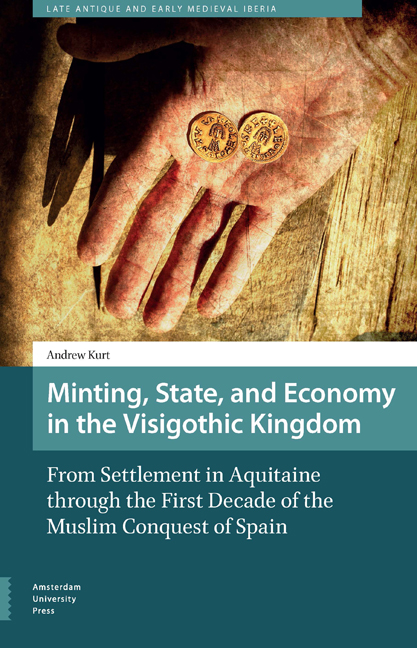 Minting, State, and Economy in the Visigothic Kingdom
Minting, State, and Economy in the Visigothic Kingdom Book contents
- Frontmatter
- Contents
- List of figures
- Acknowledgments
- Introduction
- 1 Pre-Regal Visigothic Coinage
- 2 The King’s Coinage: The Beginning and Development of theRegal Coinage (c. 573-c. 720) 81 A The Transition to a Regal
- 3 The Activities of the Mints from c. 573- c. 720
- 4 Why Were Gold Coins Struck in the Visigothic Kingdom?
- 5 The Royal Control of Visigothic Minting
- 6 Coinage in Spain in the Aftermath of the Islamic Conquest
- 7 Visigothic Currency in the Early Medieval Economy
- Conclusion
- Appendix I
- Appendix II
- Bibliography
- About the Author
- Index
5 - The Royal Control of Visigothic Minting
Published online by Cambridge University Press: 21 November 2020
- Frontmatter
- Contents
- List of figures
- Acknowledgments
- Introduction
- 1 Pre-Regal Visigothic Coinage
- 2 The King’s Coinage: The Beginning and Development of theRegal Coinage (c. 573-c. 720) 81 A The Transition to a Regal
- 3 The Activities of the Mints from c. 573- c. 720
- 4 Why Were Gold Coins Struck in the Visigothic Kingdom?
- 5 The Royal Control of Visigothic Minting
- 6 Coinage in Spain in the Aftermath of the Islamic Conquest
- 7 Visigothic Currency in the Early Medieval Economy
- Conclusion
- Appendix I
- Appendix II
- Bibliography
- About the Author
- Index
Summary
Abstract
Chapter Five demonstrates that, although specific record of minting is lacking, there can be little doubt of the ultimate royal authority behind minting, as can be ascertained from numerous numismatic and documentary elements in combination. Minting of gold was the king's affair, a prerogative based on its fiscal functionality. Gold coinage was the major medium employed to capture the wealth of the agricultural base as well as to assess and levy fines, and on the other end of the cycle to implement royal projects or otherwise make payments. Transfers in kind may still have formed a significant part of Visigothic society, but currency was without doubt a major component of state activity.
Keywords: royal; authority; control; wealth; centralization; fiduciary
“Visigothic coinage is not a measure of commercial exchanges, in which of course it can intervene, but of political power that kings can gather.”
Evidence of Royal Control
Because documentation on Visigothic minting is lacking, the fundamental question of the degree of royal authority over the striking of gold can best be fully addressed only here, at a later point of this book. One is forced to rely on the sum of the coin evidence discussed in detail above. Several aspects of the gold coinage from both the Kingdom of Toulouse and the Kingdom of Toledo have led to the common opinion that minting was tightly controlled by the Visigothic kings, in spite of the plethora of mints in the later period. For the fifth-century kingdom, these aspects are mainly the small number of mint sites and stable weights and fineness. For the regal period they include the placing of the king's name on all tremisses from early in Leovigild's reign, the rapid dissemination of generalized inscriptions, specific legends relating to royal victory, changes in type, the maintenance of theoretical standards, and royal laws concerning coined money. Our treatment of these aspects and of the primary reasons for the production of the gold coinage reinforce the notion that minting was a ‘regalía,’ as it is sometimes called in Spanish scholarship. We now explore this matter further.
- Type
- Chapter
- Information
- Minting, State, and Economy in the Visigothic KingdomFrom Settlement in Aquitaine through the First Decade of the Muslim Conquest of Spain, pp. 231 - 246Publisher: Amsterdam University PressPrint publication year: 2020


